9.3 Intelligence and Its Assessment
So far, we have considered how our species thinks and communicates. But we differ from one another in these abilities. School boards, courts, and scientists debate the use and fairness of tests that assess people’s mental abilities and assign them a score. In psychology, no controversy has been more heated than the question of whether there exists in each person a general intellectual capacity that can be measured and quantified as a number.
In this section, we consider some findings from a century of research, as psychologists have searched for answers to these questions and more:
What is intelligence?
Is intelligence one general ability or many different abilities?
How can we best assess intelligence?
What Is Intelligence?
intelligence the mental potential to learn from experience, solve problems, and use knowledge to adapt to new situations.
9-
In many studies, intelligence has been defined as whatever intelligence tests measure, which has tended to be school smarts. But intelligence is not a quality like height or weight, which has the same meaning to everyone worldwide. People assign the term intelligence to the qualities that enable success in their own time and culture (Sternberg & Kaufman, 1998). In Cameroon’s equatorial forest, intelligence may reflect understanding the medicinal qualities of local plants. In a North American high school, it may reflect mastering difficult concepts in tough courses. In both places, intelligence is the mental potential to learn from experience, solve problems, and use knowledge to adapt to new situations.
You probably know some people with talents in science, others who excel in the humanities, and still others gifted in athletics, art, music, or dance. You may also know a talented artist who is stumped by the simplest math problem, or a brilliant math student who struggles when discussing literature. Are all these people intelligent? Could you rate their intelligence on a single scale? Or would you need several different scales? Simply put, is intelligence a single overall ability or several specific abilities?

Spearman’s General Intelligence Factor
general intelligence (g) a general intelligence factor that, according to Spearman and others, underlies specific mental abilities and is therefore measured by every task on an intelligence test.
Charles Spearman (1863-
“g is one of the most reliable and valid measures in the behavioral domain . . . and it predicts important social outcomes such as educational and occupational levels far better than any other trait.”
Behavior geneticist Robert Plomin (1999)
Spearman’s belief stemmed in part from his work with factor analysis, a statistical procedure that identifies clusters of related items. In this view, mental abilities are much like physical abilities: The ability to run fast is distinct from the eye-
Theories of Multiple Intelligences
9-
Other psychologists, particularly since the mid-

GARDNER’S MULTIPLE INTELLIGENCES Howard Gardner has identified eight relatively independent intelligences, including the verbal and mathematical aptitudes assessed by standardized tests (FIGURE 9.13 below). Thus, the computer programmer, the poet, the street-

savant syndrome a condition in which a person otherwise limited in mental ability has an exceptional specific skill, such as in computation or drawing.
Gardner (1983, 2006, 2011; Davis et al., 2011) views these intelligence domains as multiple abilities that come in different packages. Brain damage, for example, may destroy one ability but leave others intact. And consider people with savant syndrome. Despite their island of brilliance, these people often score low on intelligence tests and may have limited or no language ability (Treffert & Wallace, 2002). Some can compute complicated calculations quickly and accurately, or identify almost instantly the day of the week corresponding to any historical date, or render incredible works of art or musical performance (Miller, 1999).

About four in five people with savant syndrome are males. Many also have autism spectrum disorder (ASD), a developmental disorder. The late memory whiz Kim Peek (who did not have ASD) inspired the movie Rain Man. In 8 to 10 seconds, he could read and remember a page. During his lifetime, he memorized 9000 books, including Shakespeare’s works and the Bible. He could provide GPS-
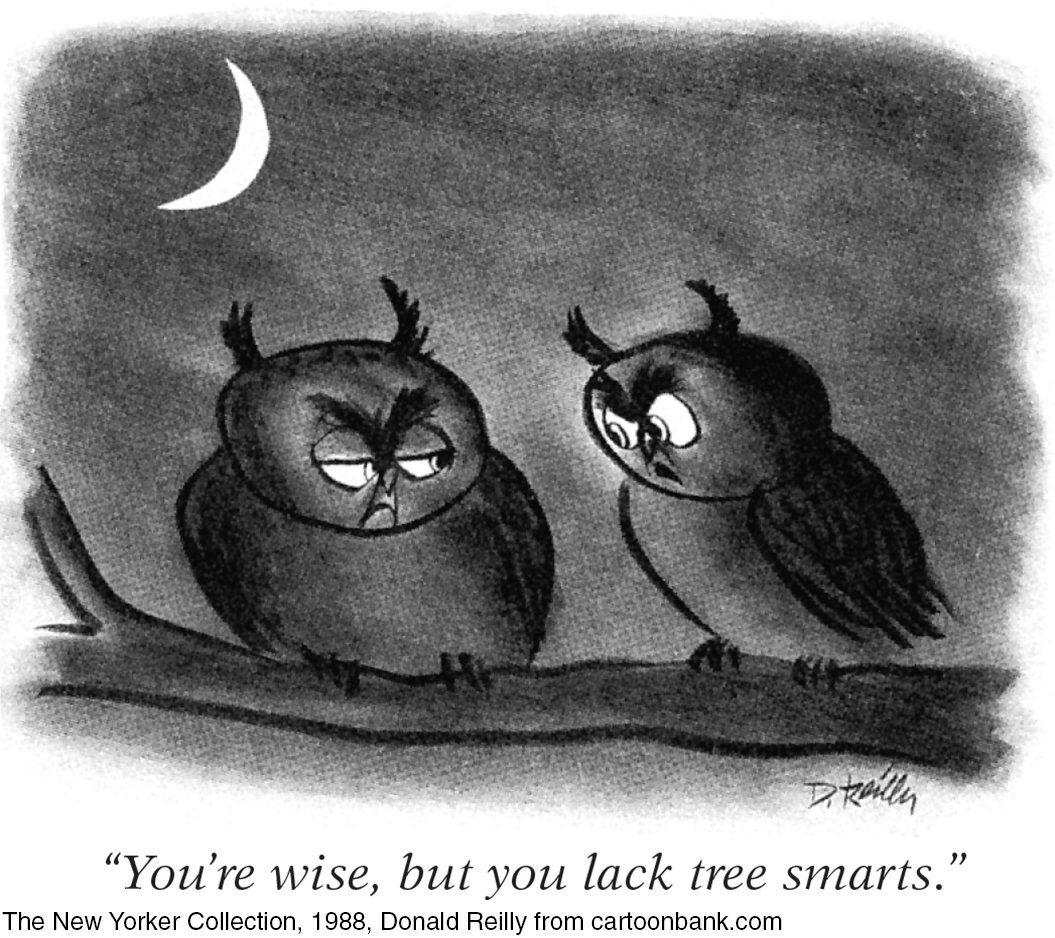
“You have to be careful, if you’re good at something, to make sure you don’t think you’re good at other things that you aren’t necessarily so good at. . . . Because I’ve been very successful at [software development] people come in and expect that I have wisdom about topics that I don’t.”
Philanthropist Bill Gates (1998)
STERNBERG’S THREE INTELLIGENCES Robert Sternberg (1985, 2011) agrees with Gardner that there is more to success than traditional intelligence and that we have multiple intelligences. But his triarchic theory proposes three, not eight or nine, intelligences:
Analytical intelligence (school smarts; traditional academic problem solving)
Creative intelligence (the ability to react adaptively to new situations and generate novel ideas)
Practical intelligence (street smarts; skill at handling everyday tasks, which may be ill defined, with multiple solutions)
Gardner and Sternberg differ in some areas, but they agree on two important points: Multiple abilities can contribute to life success, and varieties of giftedness bring spice to life and challenges for education. As a result of this research, many teachers have been trained to appreciate such variety and to apply multiple intelligence theories in their classrooms.

CRITICISMS OF MULTIPLE INTELLIGENCE THEORIES Wouldn’t it be wonderful if the world were so just that a weakness in one area would be compensated by genius in another? Alas, say critics, the world is not just (Ferguson, 2009; Scarr, 1989). Research using factor analysis has confirmed that there is a general intelligence factor (Johnson et al., 2008): g matters. It predicts performance on various complex tasks and in various jobs (Gottfredson, 2002a,b, 2003a,b; see also FIGURE 9.14). Much as jumping ability is not a predictor of jumping performance when the bar is set a foot off the ground—
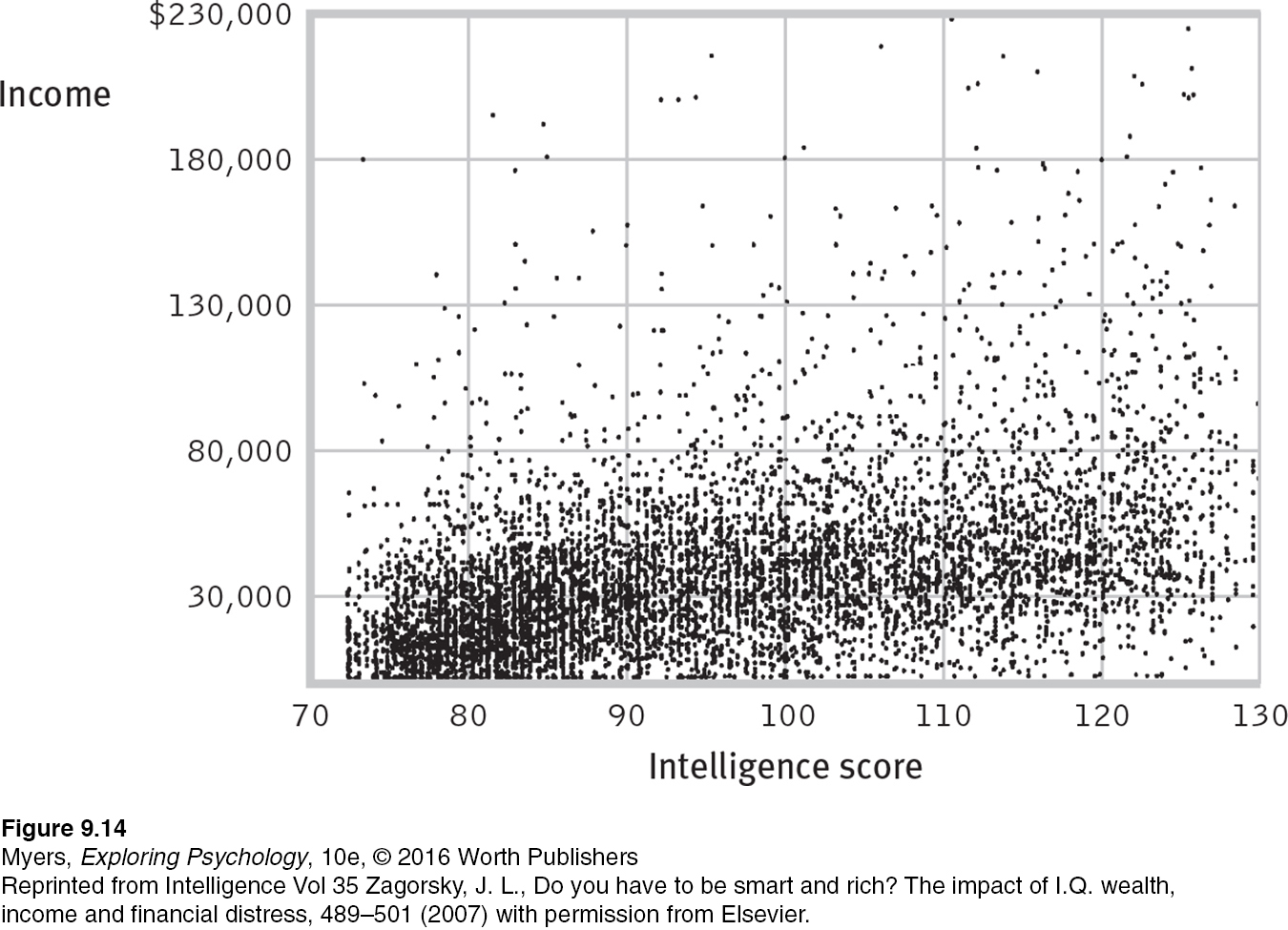

Even so, “success” is not a one-
Bees, birds, chimpanzees, and other species also require time and experience to acquire peak expertise in skills such as foraging (Helton, 2008). As with humans, performance tends to peak near midlife.
For more on how self-
RETRIEVE IT
Question
How does the existence of savant syndrome support Gardner's theory of multiple intelligences?
Emotional Intelligence
9-
Is being in tune with yourself and others also a sign of intelligence, distinct from academic intelligence? Some researchers say Yes. They define social intelligence as the know-
emotional intelligence the ability to perceive, understand, manage, and use emotions.
One line of research has explored a specific aspect of social intelligence called emotional intelligence, consisting of four abilities (Mayer et al., 2002, 2011, 2012):
Perceiving emotions (recognizing them in faces, music, and stories)
Understanding emotions (predicting them and how they may change and blend)
Page 345Managing emotions (knowing how to express them in varied situations)
Using emotions to enable adaptive or creative thinking
Emotionally intelligent people are both socially aware and self-
Some scholars, however, are concerned that emotional intelligence stretches the intelligence concept too far (Visser et al., 2006). Howard Gardner (1999) includes interpersonal and intrapersonal intelligences as two of his multiple intelligences. But let us instead, he offers, respect emotional sensitivity, creativity, and motivation as important but different. Stretch intelligence to include everything we prize and the word will lose its meaning.
The procrastinator’s motto: “Hard work pays off later; laziness pays off now.”
* * *
For a summary of these theories of intelligence, see TABLE 9.2.
Comparing Theories of Intelligence
| Theory | Summary | Strengths | Other Considerations |
| Spearman’s general intelligence (g) | A basic intelligence predicts our abilities in varied academic areas. | Different abilities, such as verbal and spatial, do have some tendency to correlate. | Human abilities are too diverse to be encapsulated by a single general intelligence factor. |
| Gardner’s multiple intelligences | Our abilities are best classified into eight or nine independent intelligences, which include a broad range of skills beyond traditional school smarts. | Intelligence is more than just verbal and mathematical skills. Other abilities are equally important to our human adaptability. | Should all of our abilities be considered intelligences? Shouldn’t some be called less vital talents? |
| Sternberg’s triarchic theory | Our intelligence is best classified into three areas that predict real- |
These three domains can be reliably measured. |
1. These three domains may be less independent than Sternberg thought and may actually share an underlying g factor. 2. Additional testing is needed to determine whether these domains can reliably predict success. |
| Emotional intelligence | Social intelligence is an important indicator of life success. Emotional intelligence is a key aspect, consisting of perceiving, understanding, managing, and using emotions. | The four components that predict social success. | Does this stretch the concept of intelligence too far? |
Assessing Intelligence
9-
intelligence test a method for assessing an individual’s mental aptitudes and comparing them with those of others, using numerical scores.
An intelligence test assesses people’s mental abilities and compares them with others, using numerical scores. Psychologists classify such tests as either aptitude tests, intended to predict your ability to learn a new skill, or achievement tests, intended to reflect what you have already learned. How do we design such tests, and what makes them credible? Consider why psychologists created tests of mental abilities and how they have used them.
aptitude test a test designed to predict a person’s future performance; aptitude is the capacity to learn.
achievement test a test designed to assess what a person has learned.
What Do Intelligence Tests Test?
9-
Barely a century ago, psychologists began designing tests to assess people’s abilities. Some measured aptitude (ability to learn). Others assessed achievement (what people have already learned).
ALFRED BINET: PREDICTING SCHOOL ACHIEVEMENT Modern intelligence testing traces its birth to early-

mental age a measure of intelligence test performance devised by Binet; the chronological age that most typically corresponds to a given level of performance. Thus, a child who does as well as an average 8-
In 1905, Binet and his student, Théodore Simon, first presented their work under the archaic title, “New Methods for Diagnosing the Idiot, the Imbecile, and the Moron” (Nicolas & Levine, 2012). They began by assuming that all children follow the same course of intellectual development, but that some develop more rapidly. A “dull” child should score much like a typical younger child, and a “bright” child like a typical older child. Binet and Simon now had a clear goal: They would measure each child’s mental age, the level of performance typically associated with a certain chronological age. The average 8-
“The IQ test was invented to predict academic performance, nothing else. If we wanted something that would predict life success, we’d have to invent another test completely.”
Social psychologist Robert Zajonc (1984b)
Binet and Simon tested a variety of reasoning and problem-
RETRIEVE IT
Question
What did Binet hope to achieve by establishing a child's mental age?
Stanford-Binet the widely used American revision (by Terman at Stanford University) of Binet’s original intelligence test.
LEWIS TERMAN: THE INNATE IQ Binet’s fears were realized soon after his death in 1911, when others adapted his tests for use as a numerical measure of inherited intelligence. Stanford University professor Lewis Terman (1877-
intelligence quotient (IQ) defined originally as the ratio of mental age (ma) to chronological age (ca) multiplied by 100 (thus, IQ = ma/ca × 100). On contemporary intelligence tests, the average performance for a given age is assigned a score of 100.


From such tests, German psychologist William Stern derived the famous intelligence quotient, or IQ. The IQ was simply a person’s mental age divided by chronological age and multiplied by 100 to get rid of the decimal point. Thus, an average child, whose mental age (8) and chronological age (8) are the same, has an IQ of 100. But an 8-
The original IQ formula worked fairly well for children but not for adults. (Should a 40-
RETRIEVE IT
Question
What is the IQ of a 4-
Wechsler Adult Intelligence Scale (WAIS) the WAIS and its companion versions for children are the most widely used intelligence tests; contain verbal and performance (nonverbal) subtests.
DAVID WECHSLER: SEPARATE SCORES FOR SEPARATE SKILLS Psychologist David Wechsler created what is now the most widely used individual intelligence test, the Wechsler Adult Intelligence Scale (WAIS). There is a version for school-

Similarities—Considering the commonality of two objects or concepts (“In what way are wool and cotton alike?”)
Vocabulary—Naming pictured objects, or defining words (“What is a guitar?”)
Block Design—Visual abstract processing (“Using the four blocks, make one just like this.”)

Letter-
Number Sequencing —On hearing a series of numbers and letters, repeat the numbers in ascending order, and then the letters in alphabetical order (“R-2- C- 1- M- 3.”)
The WAIS yields both an overall intelligence score and individual scores for verbal comprehension, perceptual organization, working memory, and processing speed. Striking differences among these individual scores can provide clues to cognitive strengths or weaknesses. For example, a low verbal comprehension score combined with high scores on other subtests could indicate a reading or language disability. Other comparisons can help a therapist establish a rehabilitation plan for a stroke patient. In such ways, these tests help realize Binet’s aim: to identify opportunities for improvement and strengths that teachers and others can build upon.
RETRIEVE IT
Question
An employer with a pool of applicants for a single available position is interested in testing each applicant's potential. To help her decide whom she should hire, she should use an (achievement/aptitude) test. That same employer wishing to test the effectiveness of a new, on-the-job training program would be wise to use an (achievement/aptitude) test.
Three Tests of a “Good” Test
9-18 What is a normal curve, and what does it mean to say that a test has been standardized and is reliable and valid?
To be widely accepted, a psychological test must be standardized, reliable, and valid. The Stanford-
standardization defining uniform testing procedures and meaningful scores by comparison with the performance of a pretested group.
normal curve the bell-
WAS THE TEST STANDARDIZED? The number of questions you answer correctly on an intelligence test would reveal almost nothing. To know how well you performed, you would need some basis for comparison. That’s why test-
If we construct a graph of test-
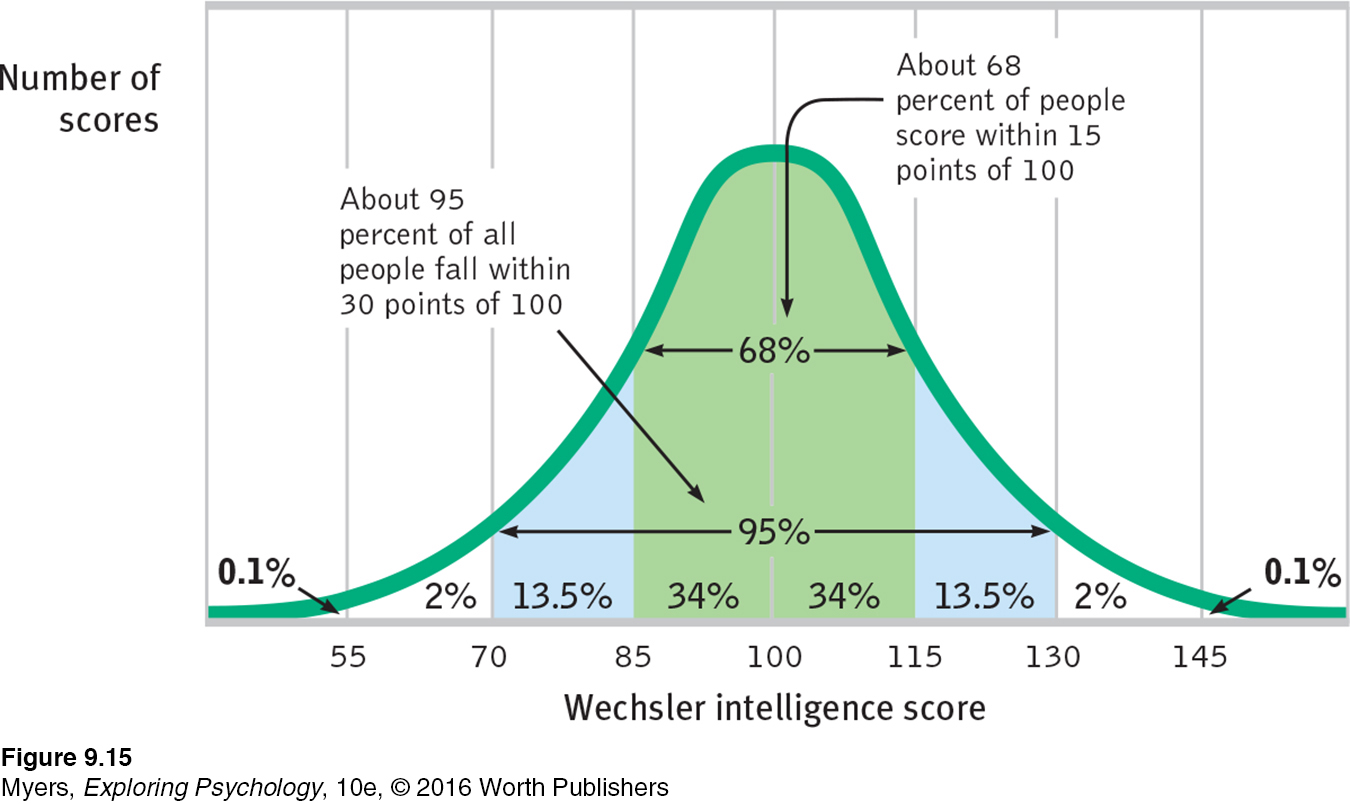
reliability the extent to which a test yields consistent results, as assessed by the consistency of scores on two halves of the test, on alternative forms of the test, or on retesting.
IS THE TEST RELIABLE? Knowing your score in comparison to the standardization group still won’t tell you much unless the test has reliability. A reliable test gives consistent scores, no matter who takes the test or when they take it. To check a test’s reliability, researchers test people many times. They may retest people using the same test, or they may split the test in half and see whether odd-
validity the extent to which a test measures or predicts what it is supposed to. (See also content validity and predictive validity.)
 See LaunchPad’s Video: Correlational Studies below for a helpful tutorial animation.
See LaunchPad’s Video: Correlational Studies below for a helpful tutorial animation.
IS THE TEST VALID? High reliability does not ensure a test’s validity—the extent to which the test actually measures or predicts what it promises. Imagine using a miscalibrated tape measure to measure people’s heights. Your results would be very reliable. No matter how many times you measured, people’s heights would be the same. But your results would not be valid, because you would not be giving the information you promised: real height.
content validity the extent to which a test samples the behavior that is of interest.
predictive validity the success with which a test predicts the behavior it is designed to predict; it is assessed by computing the correlation between test scores and the criterion behavior. (Also called criterion-
Tests that tap the pertinent behavior, or criterion, have content validity. The road test for a driver’s license has content validity because it samples the tasks a driver routinely faces. Course exams have content validity if they assess your mastery of course material. But we expect intelligence tests to have predictive validity: They should predict future performance, and to some extent they do.
The predictive power of aptitude tests is fairly strong in the early school years, but later it weakens. Past grades, which reflect both aptitude and motivation, are better predictors of future achievements.
RETRIEVE IT
Question
What are the three criteria that a psychological test must meet in order to be widely accepted? Explain.
Question
Correlation coefficients were used in this section. Here's a quick review: Correlations do not indicate cause-
The Dynamics of Intelligence
Aging and Intelligence
9-
Does intelligence increase, decrease, or remain constant as we age? The answer depends on the type of intellectual performance we measure:
crystallized intelligence our accumulated knowledge and verbal skills; tends to increase with age.
fluid intelligence our ability to reason speedily and abstractly; tends to decrease with age, especially during late adulthood.
Crystallized intelligence—our accumulated knowledge as reflected in vocabulary and analogies tests—
increases up to old age. Fluid intelligence—our ability to reason speedily and abstractly, as when solving novel logic problems—
decreases beginning in the twenties and thirties, slowly up to age 75 or so, then more rapidly, especially after age 85 (Cattell, 1963; Horn, 1982; Salthouse, 2009; 2013).
How do we know? Developmental psychologists use longitudinal studies (restudying the same group at different times across their life span) and cross-sectional studies (comparing members of different age groups at the same time) to study the way intelligence and other traits change with age. (See Appendix A for more information.) With age we lose and we win. We lose recall memory and processing speed, but we gain vocabulary and knowledge (FIGURE 9.16 below). Fluid intelligence may decline, but older adults’ social reasoning skills increase, as shown by an ability to take multiple perspectives, to appreciate knowledge limits, and to offer helpful wisdom in times of social conflict (Grossman et al., 2010). Decisions also become less distorted by negative emotions such as anxiety, depression, and anger (Blanchard-
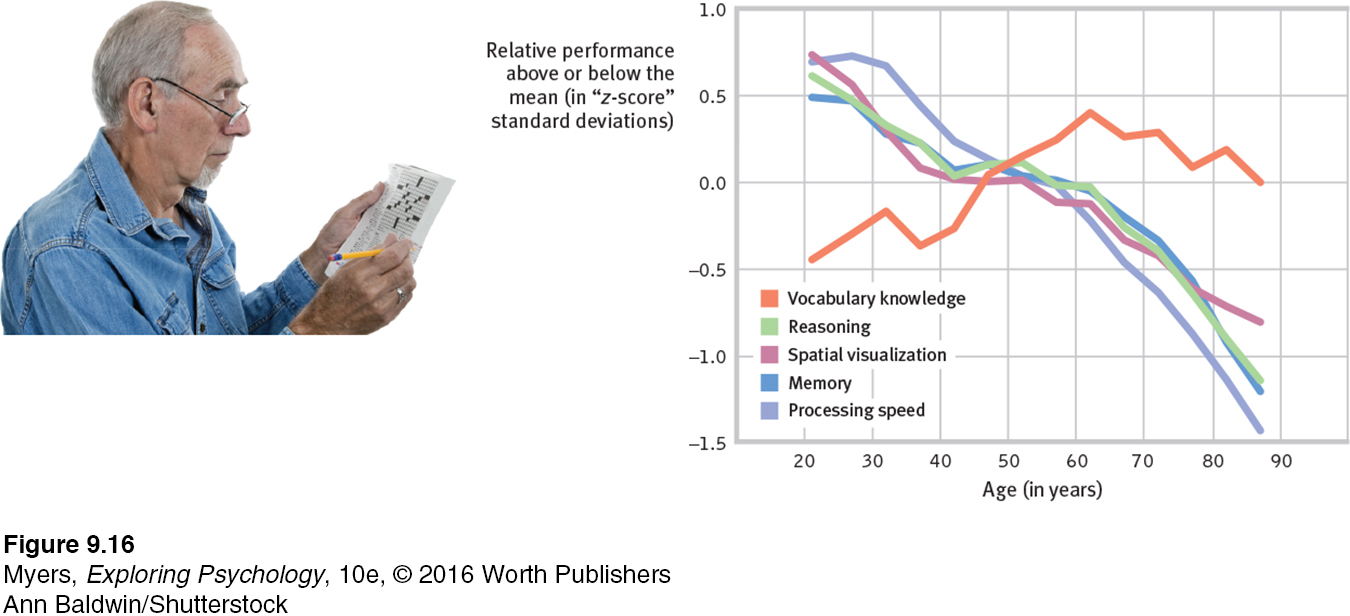
 See LaunchPad’s Video: Longitudinal and Cross-
See LaunchPad’s Video: Longitudinal and Cross-
“Knowledge is knowing a tomato is a fruit; wisdom is not putting it in a fruit salad.”
Anonymous
Age-
“In youth we learn, in age we understand.”
Marie Von Ebner-
RETRIEVE IT
Question
Researcher A is well funded to learn about how intelligence changes over the life span. Researcher B wants to study the intelligence of people who are now at various life stages. Which researcher should use the cross-
Stability Over the Life Span
9-
What about the stability of early-
By age 4, however, children’s performance on intelligence tests begins to predict their adolescent and adult scores. The consistency of scores over time increases with the age of the child. By age 11, the stability becomes impressive, as Ian Deary and his colleagues (2004, 2009, 2013) discovered. Their amazing longitudinal studies have been enabled by their country, Scotland, which did something that no nation has done before or since. On June 1, 1932, essentially every child in the country born in 1921—
And so it has, with dozens of studies of the stability and the predictive capacity of these early test results. For example, when the intelligence test administered to 11-
“Whether you live to collect your old-
Ian Deary, “Intelligence, Health, and Death,” 2005
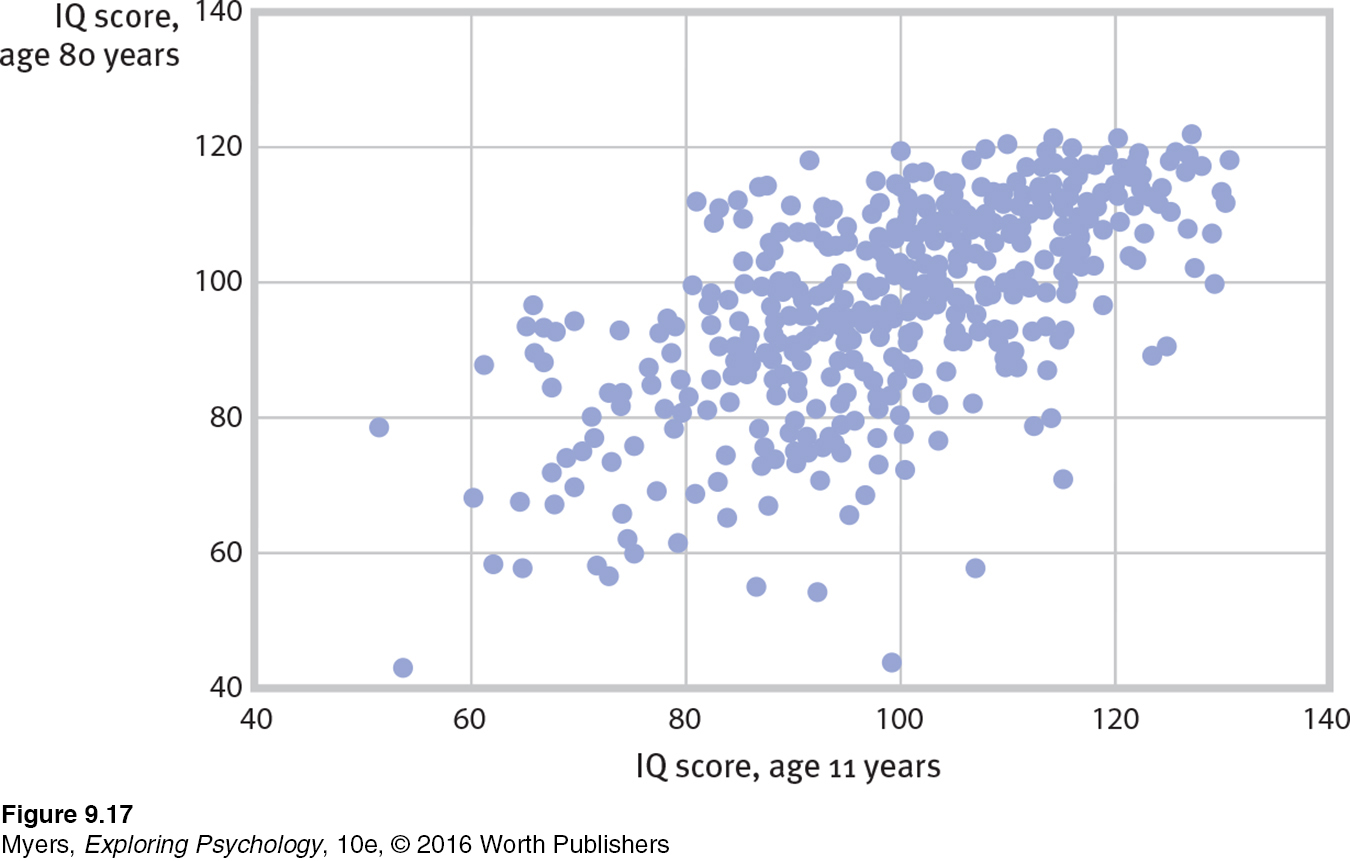
Children and adults who are more intelligent also tend to live healthier and longer lives. Why might this be the case? Deary (2008) proposes four possible explanations:
Intelligence facilitates more education, better jobs, and a healthier environment.
Intelligence encourages healthy living: less smoking, better diet, more exercise.
Prenatal events or early childhood illnesses might have influenced both intelligence and health.
A “well-
wired body,” as evidenced by fast reaction speeds, perhaps fosters both intelligence and longevity.

 IMMERSIVE LEARNING Explore how researchers have studied these issues with LaunchPad’s How Would You Know If Intelligence Changes With Age?
IMMERSIVE LEARNING Explore how researchers have studied these issues with LaunchPad’s How Would You Know If Intelligence Changes With Age?
Extremes of Intelligence
9-
One way to glimpse the validity and significance of any test is to compare people who score at the two extremes of the normal curve. The two groups should differ noticeably, and with intelligence testing, they do.
intellectual disability a condition of limited mental ability, indicated by an intelligence test score of 70 or below and difficulty adapting to the demands of life. (Formerly referred to as mental retardation.)
THE LOW EXTREME At one extreme of the intelligence test normal curve are those with unusually low scores. The American Association on Intellectual and Developmental Disabilities guidelines list two criteria for a diagnosis of intellectual disability (formerly referred to as mental retardation):
A test score indicating performance below 98 percent of test-
takers (Schalock et al., 2010). For an intelligence test with a midpoint of 100, that is a score of approximately 70 or below. Difficulty adapting to the normal demands of independent living, as expressed in three areas:
conceptual skills (such as language, literacy, and concepts of money, time, and number).
social skills (such as interpersonal skills, social responsibility, following basic rules and laws, and avoiding being victimized).
practical skills (such as daily personal care, occupational skill, travel, and health care).
Down syndrome a condition of mild to severe intellectual disability and associated physical disorders caused by an extra copy of chromosome 21.
Intellectual disability is a developmental condition that is apparent before age 18, sometimes with a known physical cause. Down syndrome, for example, is a disorder of varying intellectual and physical severity caused by an extra copy of chromosome 21.
People diagnosed with a mild intellectual disability—
RETRIEVE IT
Question
Why do psychologists NOT diagnose an intellectual disability based solely on a person's intelligence test score?
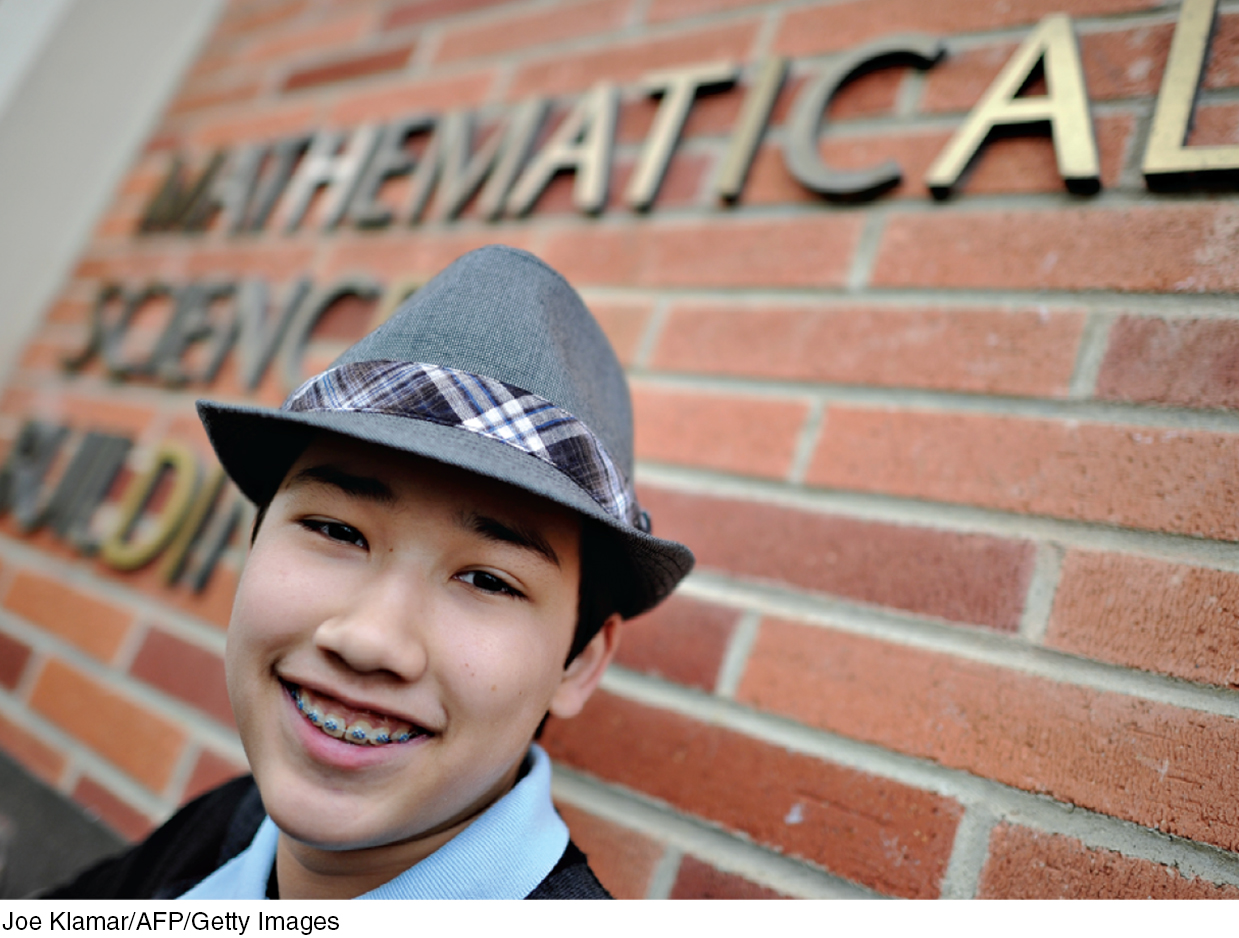
THE HIGH EXTREME In one famous project begun in 1921, Lewis Terman studied more than 1500 California schoolchildren with IQ scores over 135. Terman’s high-
Recent studies have followed the lives of precocious youths who had aced the math SAT at age 13—
One of psychology’s whiz kids was Jean Piaget, who by age 15 was publishing scientific articles on mollusks and who went on to become the twentieth century’s most famous developmental psychologist (Hunt, 1993). Children with extraordinary academic gifts are sometimes more isolated, shy, and in their own worlds (Winner, 2000). But most thrive.
REVIEW Intelligence and Its Assessment
Learning Objectives
Test Yourself by taking a moment to answer each of these Learning Objective Questions (repeated here from within the chapter). Research suggests that trying to answer these questions on your own will improve your long-
Question
9-
Question
9-
Question
9-
Question
9-
Question
9-
Question
9-
Question
9-
Question
9-
Question
9-
Terms and Concepts to Remember
Test yourself on these terms.
Question
intelligence (p. 341) general intelligence (g) (p. 341) savant syndrome (p. 342) emotional intelligence (p. 344) intelligence test (p. 345) aptitude test (p. 345) achievement test (p. 345) mental age (p. 346) Stanford- intelligence quotient (IQ) (p. 346) Wechsler Adult Intelligence Scale (WAIS) (p. 347) standardization (p. 348) normal curve (p. 348) reliability (p. 348) validity (p. 348) content validity (p. 348) predictive validity (p. 348) crystallized intelligence (p. 349) fluid intelligence (p. 349) longitudinal study (p. 349) cross- intellectual disability (p. 351) Down syndrome (p. 351) | a test designed to predict a person's future performance; aptitude is the capacity to learn. the extent to which a test samples the behavior that is of interest. (normal distribution) a symmetrical, bell- the extent to which a test yields consistent results, as assessed by the consistency of scores on two halves of the test, on alternative forms of the test, or on retesting. a method for assessing an individual's mental aptitudes and comparing them with those of others, using numerical scores. a condition of mild to severe intellectual disability and associated physical disorders caused by an extra copy of chromosome 21. the widely used American revision (by Terman at Stanford University) of Binet's original intelligence test. the ability to perceive, understand, manage, and use emotions. a study in which people of different ages are compared with one another. a test designed to assess what a person has learned. our accumulated knowledge and verbal skills; tends to increase with age. a general intelligence factor that, according to Spearman and others, underlies specific mental abilities and is therefore measured by every task on an intelligence test. a condition in which a person otherwise limited in mental ability has an exceptional specific skill, such as in computation or drawing. our ability to reason speedily and abstractly; tends to decrease with age, especially during late adulthood. defining uniform testing procedures and meaningful scores by comparison with the performance of a pretested group. a condition of limited mental ability, indicated by an intelligence test score of 70 or below and difficulty adapting to the demands of life. (Formerly referred to as mental retardation.) defined originally as the ratio of mental age (ma) to chronological age (ca) multiplied by 100 (thus, IQ = ma/ca × 100). On contemporary intelligence tests, the average performance for a given age is assigned a score of 100. a measure of intelligence test performance devised by Binet; the chronological age that most typically corresponds to a given level of performance. Thus, a child who does as well as an average 8- the success with which a test predicts the behavior it is designed to predict; it is assessed by computing the correlation between test scores and the criterion behavior. (Also called criterion- the mental potential to learn from experience, solve problems, and use knowledge to adapt to new situations. research in which the same people are restudied and retested over a long period. the extent to which a test measures or predicts what it is supposed to. (See also content validity and predictive validity.) the WAIS and its companion versions for children are the most widely used intelligence tests; contain verbal and performance (nonverbal) subtests. |
Experience the Testing Effect
Test yourself repeatedly throughout your studies. This will not only help you figure out what you know and don’t know; the testing itself will help you learn and remember the information more effectively thanks to the testing effect.
Question 9.13
1. Charles Spearman suggested we have one underlying success across a variety of intellectual abilities.
Question 9.14
2. The existence of savant syndrome seems to support
| A. |
| B. |
| C. |
| D. |
Question 9.15
3. Sternberg's three types of intelligence are , , and .
Question 9.16
4. Emotionally intelligent people tend to
| A. |
| B. |
| C. |
| D. |
Question 9.17
5. The IQ of a 6-year-old with a measured mental age of 9 would be
| A. |
| B. |
| C. |
| D. |
Question 9.18
6. The Wechsler Adult Intelligence Scale (WAIS) is best able to tell us
| A. |
| B. |
| C. |
| D. |
Question 9.19
7. The Stanford-
Question 9.20
8. Use the concepts of crystallized and fluid intelligence to explain why writers tend to produce their most creative work later in life, and scientists may hit their peak much earlier.
Question 9.21
9. Which of the following is NOT a possible explanation for the fact that more intelligent people tend to live longer, healthier lives?
| A. |
| B. |
| C. |
| D. |
Use  to create your personalized study plan, which will direct you to the resources that will help you most in
to create your personalized study plan, which will direct you to the resources that will help you most in  .
.